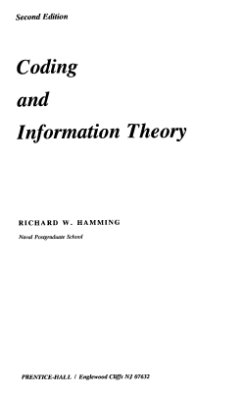Prentice Hall, 1986. - 272 pages.
Preface to the First Edition: This book combines the fields of coding and information theory in a natural way. They are both theories about the representation of abstract symbols. The two fields are now each so vast that only the elements can be presented in a short book.
Information theory is usually thought of as "sending information from here to there" (transmission of information), but this is exactly the same as "sending information from now to then" (storage of information). Both situations occur constantly when handling information.
Clearly, the encoding of information for efficient storage as well as reliable recovery in the presence of "noise" is essential in computer science. Since the representation, transmission, and transformation of information are fundamental to many other fields as well as to computer science, it is time to make the theories easily available. Whenever and wherever problems of generation, storage, or processing of information arise, there is a need to know both how to compress the textual naaterial as well as how to protect it against possible mutilation. Of the many known encoding methods, we can indicate only a few of the more important ones, but hopefully the many examples in the text will alert the student to other possibilities.
The text covers the fundamentals of the two fields and gives examples of the use of the ideas in practice. The amount of background mathematics and electrical engineering is kept to a minimum. The book uses, at most, simple calculus plus a little probability theory, and anything beyond that is developed as needed. Techniques that have recently arisen in computer science are used to simplify the presentation and the proofs of many results. These techniques are explained where they are used, so no special knowledge of computer science is required.
Preface to the First Edition: This book combines the fields of coding and information theory in a natural way. They are both theories about the representation of abstract symbols. The two fields are now each so vast that only the elements can be presented in a short book.
Information theory is usually thought of as "sending information from here to there" (transmission of information), but this is exactly the same as "sending information from now to then" (storage of information). Both situations occur constantly when handling information.
Clearly, the encoding of information for efficient storage as well as reliable recovery in the presence of "noise" is essential in computer science. Since the representation, transmission, and transformation of information are fundamental to many other fields as well as to computer science, it is time to make the theories easily available. Whenever and wherever problems of generation, storage, or processing of information arise, there is a need to know both how to compress the textual naaterial as well as how to protect it against possible mutilation. Of the many known encoding methods, we can indicate only a few of the more important ones, but hopefully the many examples in the text will alert the student to other possibilities.
The text covers the fundamentals of the two fields and gives examples of the use of the ideas in practice. The amount of background mathematics and electrical engineering is kept to a minimum. The book uses, at most, simple calculus plus a little probability theory, and anything beyond that is developed as needed. Techniques that have recently arisen in computer science are used to simplify the presentation and the proofs of many results. These techniques are explained where they are used, so no special knowledge of computer science is required.

